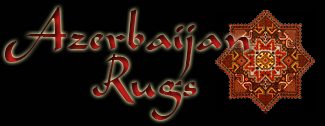
 |
|
|
Sheep Breeds of Azerbaijan
by Vugar Dadashov
8000 years ago, it is believed that there were only 3 main breeds in the territory of today’s Azerbaijan, according to the found archeological materials. Three regions, Caucasia and the neighboring regions, Italy and Spain, nearly monopolized the production of fine wool for nearly three thousand years, to the beginning of the 19th century. In the 19th century, there were 9 known breeds of sheep (Bozakh, Balbas, Mazekh, Merino, Herik, Shirvan, Shahsevan, Karabakh and Lezgi breeds) in northern part of Azerbaijan (Arran). Today there are more than local 15 sheep breeds in Azerbaijan each breed produces a unique type of wool.
Local sheep breeds are:

Table 1. Sheep Breeds of Azerbaijan - Regional Classification.

Table 2. Main breeds and National Selections

Table 3. Sheep Breeds of Azerbaijan - Wool Types & Characteristics
|
|
Map shows the distribution of the sheep breeds according to
the regions of Azerbaijan.
red coloured text = breeds with fine fleece
blue coloured text = breeds with semi rough wool
black coloured text = breeds with rough wool
Shahsavan or Mughan (Moghani) Breed Found on the Moghan steppe of Republic of Azerbaijan and also in Southern Azerbaijan (Iran), the Shahsavan or Moghani are a fat-tailed meat breed with carpet quality wool. They are usually are solid white but occasionally pale colored markings will be found in the head and feet. The rams are usually polled and the ewes are polled. |
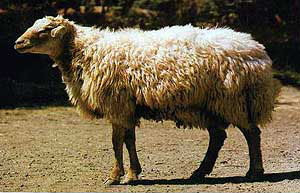 |
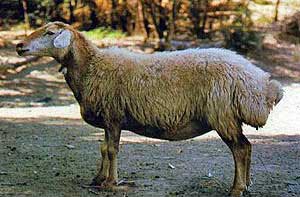 |
|
Gedebey Merino / Azerbaijan
Mountainous Merino Azerbaijan mountainous merino sheep was established as a result of long-term breeding-selection work by crossing the local Gedebey merino sheep with fat-tailed bozakh sheep and Askaniy merino sheep. The authors of this breed of sheep are academician F.A.Melikov, senior lecturer M.N.Sadigov and other scientists. Azerbaijan mountainous merino sheep breed was authorized in 1947. In comparison with local Gedebey merino sheep Azerbaijan mountainous merino sheep is bigger. The head is covered with more wool. The live weight of ewe is 40-50 kg, ram’s 75-90 kg. On average 7-10 kg wool is sheared from one ram and 4-6,5 kg from one ewe. Fat content of milk is 5,6-6,0 %. Azerbaijan mountainous merino sheep is widely distributed in Ganja-Gazakh (Kazak) zone. |
|
|
Balbas
The Balbas is the most valued semi coarse wooled breed raised in Azerbaijan. These sheep were brought to Azerbaijan by nomads who used to bring their flocks to local summer ranges. They have been selected for production of meat, fat and milk and adaptability to transhumance husbandry. The breed regionalization plan zones the breeding of Balbas sheep in the territory of Nakhchyvan (Nakhichevan) AR of Azerbaijan and today’s Republic of Armenia. Sheep are kept on mountain pastures for 220-255 days and they spend 110-145 winter days in confinement. This pattern has always been the most rational one and will continue to be so in the future. Numbers have increased considerably since 1964 and in 1980 stood at 355 331 (95% purebred) including 11 652 breeding rams, 3783 other rams and 211 660 ewes and yearlings. Balbas sheep have a strong constitution and ample bone. They are rather large in size and are known for their weight, pronounced meat traits, satisfactory wool production and fertility. Both rams and ewes are hornless; horned rams occur occasionally. The head is medium-sized, with a straight profile; rams are slightly Roman-nosed. Ears are long. The neck and the body are slightly elongated. The back is level and straight. The chest is deep, sufficiently wide and full. The rump is somewhat sloping. The udder is well developed. Sheep are well legged; the legs are strong, muscular, with tough hoofs. The tail is of medium size and consists of two pads, a larger lower and a smaller upper one; it hangs below the hocks. The colour is predominantly white, with dark spots on face, ears, and lower limbs. Head, neck and legs are without wool. Balbas sheep in the Nakhchyvan (Nakhichevan) have shorter legs and a longer body than their relatives in the territory of today’s Armenia. The Balbas are the largest among all local Transcaucasian breeds, not only in terms of their live weight but also in size. The average live weight of rams is 83.9 kg (range 65-105 kg). The average live weight of elite rams used at state breeding stations may reach 102 kg and that of Grade one rams is 75.6-79.2 kg. The average live weight of breeding ewes is 55-58 kg in autumn and 50-53 kg in spring. The tail fat weighs 10-12 kg in rams and 5-6 kg in ewes. Newborn lambs weigh 3.5-4.3 kg; at weaning (4-4.5 months) males weigh 25.2 kg and females 23.3 kg. The average daily gain during suckling is 160 g for males and 148 g for females. The carcass yield is 50-62% and the yield of choice cuts is 83-85%. Meat yield is 80-84% of the carcass weight. Balbas sheep are known for their good milk yield: the average per lactation is 100 kg (range 85-130 kg). The yield of marketable milk in the shorter lactation period of 80-90 days is 30-35 kg. Sheep in the Nakhchyvan (Nakhichevan) have a higher milk yield; they produce 68-80 kg per ewe. The fatness of milk reaches 5,4-7 percent. The average fleece weight of purebred elite rams is 3.5 kg; it is 2.5 kg for first-grade rams, and 2.4 and 1.9 kg for elite and first-grade ewes respectively. The average fleece weight in ordinary flocks ranges from 1.2 to 2.2 kg per head. Breeding rams used at state breeding stations have higher fleece weights (3.6-4.1 kg). The fleece weight of Balbas sheep registered in Volume I of the State Flockbook was 3.2 for rams (range 2.6-5.0 kg) and 2.7 kg for ewes (range 2.2-4.5 kg). Balbas sheep normally are sheared twice a year (spring and autumn) The fleece hangs in pointed locks. The wool is shiny white or light grey, with slight lustre. It is suitable for worsted spinning and is widely used in carpet making and valued by artisans. The fleece consists of true wool, intermediate fibres and guard hair. The staple length is 18.0 cm for ewes and 13.5 cm for yearlings; the true wool length is 12.1 cm and 9.8 cm respectively. Sheep raised in the Nakhchyvan (Nakhichevan) have shorter wool. Staple length in ewes is 13-17 cm, and the wool length is 7.5-8.5 cm. The fibre fineness in Balbas sheep from the territory of today’s Armenia is as follows: wool 27.0-32.9 μ intermediate fibres - 39.7-53.6 μ and short guard hair -53.5-109.4 μ. The corresponding figures for Nakhchyvan Balbas are 21.1-23.7, 33.8-36.6, and 51.6-58.5 μ. These figures show that the undercoat in Balbas sheep is coarse and very close to intermediate fibres in fineness. The guard hair on the other hand is thin thus producing greater evenness in comparison with wool of other coarsewooled breeds. The clean wool yield varies from 50 to 65%. It should be noted that the wool is dry because of the shortage of yolk. Sheep with evener and more uniform wool of better quality have yolk of a yellow colour. Sheep with uneven and non-uniform wool have kemps. Lambing rate is 100-102 lambs dropped per hundred ewes lambing but in the best flocks the figure is 110-115. As a highly productive breed, which is well adapted to local conditions, the Balbas is used for improving productivity, particularly of meat, in other coarse-wooled Transcaucasian breeds. |
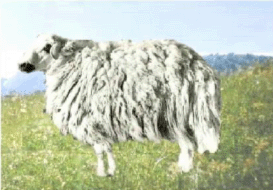 |
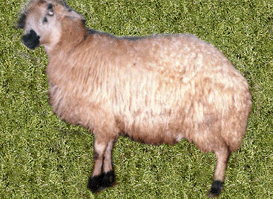 |
|
Karabagh Breed
Karabakh sheep is one of ancient sheep breeds of Azerbaijan. This breed of sheep is spread in many regions of the republic and is reared in Karabagh (Garabagh), Central Steppe and Mugan-Salyan zones of Azerbaijan. They are a coarse-wooled breed of the mutton-wool-milk type. Karabakh ewes are hornless; rams can be horned or hornless. There is no wool on head, limbs, abdomen and the bottom part of neck; exceptionally the head is covered by short wool. Ear length varies greatly; there are sheep with long or short ears or none. These sheep are small in size; the live weight of ewes is 47-51 kg and that of rams is 61-74 kg. Average withers height is 64.6 cm (range 53-74 cm), chest girth 63.1 cm (range 55-70 cm), chest depth 29 cm (range 18-34 cm). The colour is usually dirty white or light brown, occasionally black or white. The tail is S-shaped; fat is deposited along its length except for the last two sections. Ewes are shorn twice a year, giving a total of 1.5-2.3 kg of wool. Rams are shorn once and produce up to 3.2 kg per head, with clean wool yield of 75-76%. Lustre is poor. The wool contains 50.8% of true wool, 10.1% of intermediate fibres, 23.7% of guard hair, and 15.4% of short guard hair. The length of wool fibres is 7 cm, of intermediate fibres 8 cm, of guard hair 8 cm, and of short guard hair 3 cm. Fibre diameter is 33.8, 47.1, 66.6 and 156 μ respectively. Milk yield is satisfactory; ewes produce 35-40 kg of marketable milk. Fatness of milk is 7,6 percentMilk is used for the production of butter and fresh cheese called pendir. In spite of their low clip of rather coarse wool, Karabakh sheep are kept because of their hardiness and ability to subsist on rough forage, to gain weight on grazing and to traverse long distances. They are on pasture throughout the year. In summer they graze in the lowlands and in winter in the highlands, on alpine pastures. To get from winter quarters to summer ranges sheep cover 200-250 km and in some cases even up to 300 km. Sheep of the Karabakh breed are raised only on private plots in Azerbaijan. Every 100 ewes give birth to 100-115 lambs a year. |
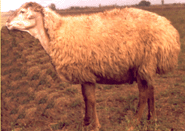 |
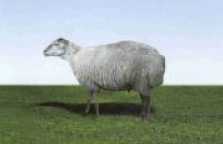 |
|
Lezgi Breed
Lezgi sheep belong to the group of Caucasian fat-tailed breeds and they are the result of national selection. They were described for the first time in 1912 when they were exhibited at the All-Russia Sheep-breeding Exhibition. They are raised in the northern zones such as Zagatala, Gazakh, Sheky, Yevlakh, Goychay, Agdash and Gabala regions of Azerbaijan. This area is characterized by a mountainous relief and a great variety of climatic, soil and feeding conditions. Sheep are usually kept on a transhumance system in order to utilize the grasslands of both mountain and plains. They got used to the local climatic and forage conditions of the Great Caucasus. The number of sheep of this breed has increased over 20 times since 1964. The total in 1980 was 237 774 (32% purebreds) including 5344 breeding rams, 14 501 other rams and 134 809 ewes and yearlings. Lezgi sheep have a strong constitution and are good walkers. They have the ability to be driven to 300-400 km long distances between the summer and winter pastures every year. Their conformation is typical of mountain sheep. They have an ample and fine bone, a somewhat elongated body on relatively short legs with tough hoofs. The tail is fat, of medium size, S-shaped. The tip of the tail is lean, free of fat deposits and hanging down. Animals are usually horned. In general, Lezgi sheep are small in size. The average withers height of ewes is 57.9 cm, rump height 59.1 cm, oblique body length 58.8 cm and chest girth 71.9 cm. The live weight of ewe is 30-37 kg, of ram’s 45-50 kg. Some 75% of Lezgi sheep are white, often with coloured spots on the head, neck, and feet. Some 16% are black or black-brown and the rest (8-10%) are tan of various shades, grey or pied. The fleece cover is satisfactory and only 10-12% of sheep are poorly covered. The forelegs are usually covered with wool down to the knees and the hindlegs down to the hocks. Sheep are shorn twice a year - in April and August-September. The spring fleece weight in ewes is 1.0-1.6 kg and the autumn one 0.4-0.8 kg (on average 1.4 kg anually). Rams produce 1.4-2.2 kg in spring and 0.6-1.0 in autumn (2-3 kg anually). Lambs over one year of age clip 0.8-1.0 kg in spring and 0.4-0.9 kg in autumn. The wool hangs in pointed locks; its quality is one of the best among coarsewooled breeds. Staple length is 14 cm (range 7-17.5 cm). True wool accounts for 60.5% (range 14.3-82.6%), guard hair for 1.7% (range 0.6-12.2%), and intermediate fibres for 37.8% (range 15.7-67.7%). The true wool length is 4 cm and the diameter is 16.0-29.5 μ, the length of intermediate fibres is 14.9 cm, and the diameter 30.0-57.8 μ. The diameter of guard hair ranges from 65.4 to 103.6 μ. Among local coarsewooled breeds the Lezgi is distinguished by high milk yield - 65-80 litres per lactation, with marketable milk amounting to 35-40 litres. Ewes are usually milked from April to September. The best flocks of the Lezgi breed are raised in the border of Azerbaijan and Dagestan. Further breeding and selection are aimed at increasing live weight and wool clip, and improving the quality of the carpet wool without any reduction in adaptation to local natural conditions. |
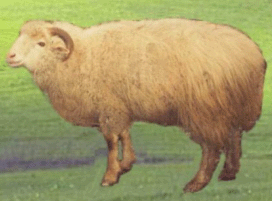 |
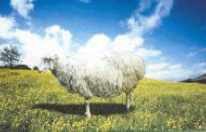 |
|
Shirvan Breed
The sheep of this breed are a mutton-wool-milk type of ancient origin. They are bred chiefly in the east and central regions of Azerbaijan on the left bank of the river Kura mainly in the Mugan, Salyan and Shirvan steppes and on the Apsheron peninsula. Exterior and productivity qualities of them are close to Karabakh breed of sheep, however they look like a little to lezgi sheep breed in terms of the tail form and quality of wool. As shown by their measurements (see Table) and live weight they are a large breed. Table. BODY MEASUREMENTS OF SHIRVAN SHEEP (CM)
Shirvan sheep are smaller than the Karabakh and they have a somewhat flatter and shorter body. The average live weight of ewes is 43 kg (range 33-59 kg) and of rams 50.7 kg (range 46-55 kg). On grazing, animals make high live-weight gains. The slaughter yield is 47%. Fleece of Shirvans hangs in pointed locks and has a lot of brittle hair (kemp). The fleece weight (in 2 shearings) of ewes is 1,6-2,2 and that of rams 1.9-2.8 kg. Yearling sheep give 1.1-1.5 kg of wool, and lambs 0.3-0.4 kg. About 18 percent of wool is fine-fleeced and reminds wool of lezgi sheep. The rest is mostly coarse and partly semi coarse. Most sheep (73%) are white with a red or greyish shade; the rest are black, black-brown, or light brown. Up to 8 percent of sheep is pure white. Sheep of Mugan-Salyan regions got accustomed to the severe dry hot climate and they have coarser wool. Shirvan wool contains 38% of true wool, 18-20% of intermediate hair, 20-22% of guard hair and not less than 20% of dead hair (kemp) and sometimes 30%. The staple length varies from 7.2 to 12.3 cm. The average diameter of true wool is 25.6 μ, of intermediate hair 38.5-46.8 μ and of guard hair 118-132 μ. The lambing rate is 105-110 lambs per 100 ewes lambing. The live weight of newborn lambs is 2-4 kg. Ewes yield 40-60 litres of milk per lactation, the yield depending on the type of the sheep. Southern Shirvan sheep are valued for their good adaptation to the hot climate of the Mugan-Salyany areas of Azerbaijan. During long droughts as well as in cold snowy periods in winter sheep get supplementary hay and concentrate feeding. Most of these sheep (up to 80%) are being crossed with the Azerbaijan Mountain Merino to improve mutton, wool and milk performance. As a result purebred Shirvan sheep remain only on individual holdings in Apsheron, Lenkaran, Masalli and Sumgait regions of Azerbaijan. |
|
||||||||||||||||||||||||||||||||||||||||||||
|
Gala Gala sheep is a product of national selection. They are raised under the dry subtropical climatic conditions of Absheron region. Their origin comes from the tough-woolen Shirvan breed. 2 pedigree farms are engaged in raising of these sheep. In order to use these farms in the lowland and foothill zones, 1000-1500 head of small ruminants are sold every year as a pedigree sheep. The live weight of ram is 56-100 kg and ewe is 48-76 kg. The tail of Gala sheep is hanging down and consists of two parts. The weight of fat-tail makes 6,3-10 kg. 3,4-4,5 kg wool is sheared from one ram a year and 2,8 kg from one ewe. Head is large, ears are long, limbs are high. They give about 61 kg of milk a year. Every 100 ewes give birth to 102-110 lambs a year. Gala sheep are kept in winter pastures the whole year round.
|
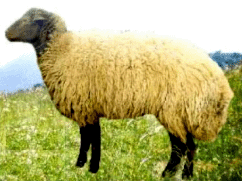 |
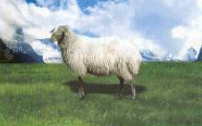 |
|
Bozakh There are 3 types of Bozakh sheep:
1)Gumral
(Brown) Bozakh was developed in the mountain regions of Ganja-Gazakh (Kazak) regions of Azerbaijan. (Gazakh, Agstafa, Tovuz, Shamkir, Gedebey, Khanlar) It is a product of national selection and was established by crossing Garabakh and Tush sheep. The constitution of them is dry, strong. They got used to the local mountainous and foothill climatic conditions and to the migratory and semi-migratory driving conditions. They are resistant to be driven 400-500 km, the distance to Jeyranchol winter pastures and mountainous summer pastures of Little Caucasus. Animals have long ears and a broad tail, consisting of two half-open lobes and a little appendage. They are fairly large: ewes weight 45-55 kg, rams about 55-65 kg. Lambs at birth weigh 3.3-3.5 kg and at weaning 20-22 kg. According to M.F. Ivanov, Bozakh sheep have the following measurements: height at withers 61.7 cm (range 53-71 cm), chest girth 86.6 cm (range 73-102 cm), chest depth 28.5 cm (range 24-33 cm). Rams and ewes are mainly polled. The facial profile is straight; the head is covered with short wool. Belly covering is good. Wool colour is chiefly dirty white or yellow-white; brown, light tan, grey or black colour. Sometimes tinged with violet is occasionally seen. In most cases head and legs are some shade of brown; occasionally they are grey or another colour. The wool production in two shearings per year is 1.8-2.5 kg from a ewe and 3 kg from a ram with a clean wool yield of 75-80%. The wool is lustrous. It contains 32.4% of true wool, 17.8% of intermediate fibres and 49.8% of guard hair. The average fibre length on the sides is as follows: true wool 8 cm, intermediate hair 10 cm, guard hair 12 cm, and short guard hair 5 cm; fibre diameter is 29.9 μ 38.7 μ 61.2 μ and 84.7 μ respectively. Milk production is satisfactory: 36-38 kg of marketable milk annually. The rate of giving birth to twins is 10-25 percent. There are 3 types of Bozakh sheep: 1)Gumral
(Brown) |
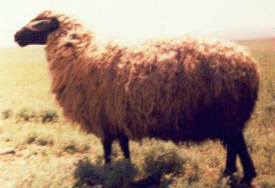 |
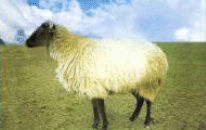 |
|
Gödek |
|
|
Garadolaq / Karadolakh The average live weight of Karadolakh ewes in autumn is 66 kg (range 49-89 kg) and that of rams is 81.8 (range 63-101 kg). Yearling ewes in spring weigh 40-42 kg. The weight gain in ewes during the four summer months is 20% of the spring live weight. The corresponding figure in rams is 15%. Fat deposits in the tail of fattened wethers amount to 12 kg. Karadolakh sheep have a somewhat higher fleece weight. The wool is semi-rough and sometimes is fine fleeced. 2,5-3 kg wool is sheared from rams a year. Ewes shorn twice a year produce 2.5-2.9 kg. The clean wool yield is 71-76%. The fleece contains up to 12% of kemp. True wool accounts for 54-56%, guard hair 27% or more, and intermediate fibres 5-6%.
|
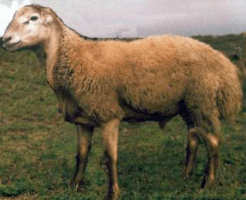 |
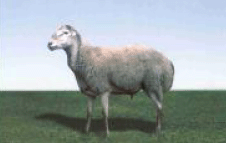 |
|
Mazekh It is a product of national selection. This breed is similar with balbas breed of sheep in appearance. They are fat-tailed and the tail is consisted of two parts. There is no wool on their head, neck and abdomen. Up to 10 percent is white colour and small number are black. The live weight of ewe is 45-57 kg, and ram’s 67-78 kg. Mazekh sheep are sheared once a year. The wool of Mazekh sheep is rough, 1,4 kg wool is sheared from one ewe and 1,7 kg from one ram a year. Milk productivity is 75-90 kg a year. Every 100 ewes give birth to 100-115 lambs a year. Mazekh sheep are clipped twice a year (spring and autumn) Mazekh sheep are crossed with Balbas rams in Nakhchivan Autonomous Republic. They are also reared in the boundary zones of Azerbaijan with Georgia.
|
|
|
Herik
Herik sheep are established by national selection. Herik sheep have rough wool and are reared in Shaky-Zagatala zone of the country. They were crossed with Tush ram in order to increase the wool productivity and live weight of lezgy sheep. The received hybrids then were raised and called as Herik breed. Herik differs from Lezghin sheep hybrids a little. Hybrids established as a result of crossing Tush and bozakh breeds in Ganja-Gazakh zone are also called Herik. |
|
|
Jaro |
|
|
Tush / Tushin
Breed
The Tushin sheep exhibit sturdiness and good adaptation to transhumance husbandry. When moving from winter quarters to summer ranges they can easily cover more than 500 km. Tushin sheep have a strong constitution, a harmonious and compact conformation, ample bone, and tough hoofs. The brisket is full and round and the ribs are well sprung. The head has a straight profile. Rams have horns and ewes have rudimentary horns. The animals are relatively small in size. Withers height is 58-60 cm, chest girth 83-85 cm, and depth of chest 29-30 cm. The average live weight of rams is 58-60 kg and that of ewes is 40-42 kg. Table 4.9 shows the live weight at different ages under transhumance conditions. Tushin sheep produce coarse wool of better quality than nearly all other coarsewooled mountain breeds. The wool is white and lustrous. The first-grade wool contains 74% of true wool and intermediate fibres and 26% of guard hair. The diameter of true wool is 56 μ. The second and third-grade wool contains less true wool (35-44% respectively), and more guard hair (55-65% respectively). The diameter of true wool fibres is 26 and 27 μ respectively and that of guard hair is up to 70 μ. The locks are very wavy, 12-16 cm long. The wool of Tushin sheep is particularly valued in carpet making; it is also used for the production of worsted and cloth fabrics, and felt. The annual fleece weight for rams is 3.1-3.8 kg and that for ewes is 2.4-3.0 kg. Table 4.9 LIVE WEIGHT OF TUSHIN SHEEP AND LAMBS (KG)
Tushin sheep are fat-tailed. Fat is deposited on the rump, in the thighs, and in the tail in the form of a fatty pad which is internally divided into two by a groove. The tail is of medium size or short; its tip is thin and free of fat. According to the shape and size of fat deposits, two types of sheep are distinguished: dumeuli and kentuli. The former have larger and somewhat pendent tails, which sometimes reach the hocks; the latter have raised tails at the height of the rump. The meat of Tushin sheep is known for its palatability and a nice aroma free of the specific acrid smell of mutton. The carcass yield of meat and fat is 42.7-47.7% in wethers and 42.6-44.4% in ewes. With good feeding the carcass yield of fat rams at the age of 9-12 or 18 months is 50-56% of the live weight; the carcass weight ranges from 19 to 23 kg. In ewes the corresponding figures are 50-57% and 20.2-28.7 kg. Milk yield is not high, 65-70 kg per lactation, of which marketable milk constitutes 10-15 kg. Lambing rate is rather low - 105-115 lambs dropped per hundred ewes lambing. The number of Tushin sheep has increased three and half times over the last fifteen years. In 1980 the total was 928 136 (76% purebred) including 37 433 breeding rams, 19 109 other rams and 561 578 ewes and yearlings. For improvement in breeding flocks pure breeding is used. Thus preservation of the breeding type is ensured and hereditary stability of typical traits is increased. In all districts designated for raising of Tushin sheep grading up is widely used, which contributes to further growth of the Tushin population.
|
|
Lamb Wool
|
|
The quality of wool is determined by the following factors, fiber fineness, length, scale structure, color, cleanliness, and freedom from damage. For example merino wool is typically 7-12cm (3-5 inches) in length and is very fine (between 12-24 microns). Wool taken from sheep produced for meat is typically more coarse, and has fibers are 1.5 to 6 inches in length. Damage or "breaks in the wool" can occur if the sheep is stressed while it is growing its fleece, resulting in a thin spot where the fleece is likely to break.
Wool is also separated into grades based on the measurement of the wool's diameter in microns. These grades may vary depending on the breed or purpose of the wool. For example:
Coarser wool types can be classified as:
In general, anything smaller than 25 microns can be used for garments, while coarser grades are used for outerwear or rugs. The finer the wool, the softer it will be, while coarser grades are more durable and less prone to pilling.
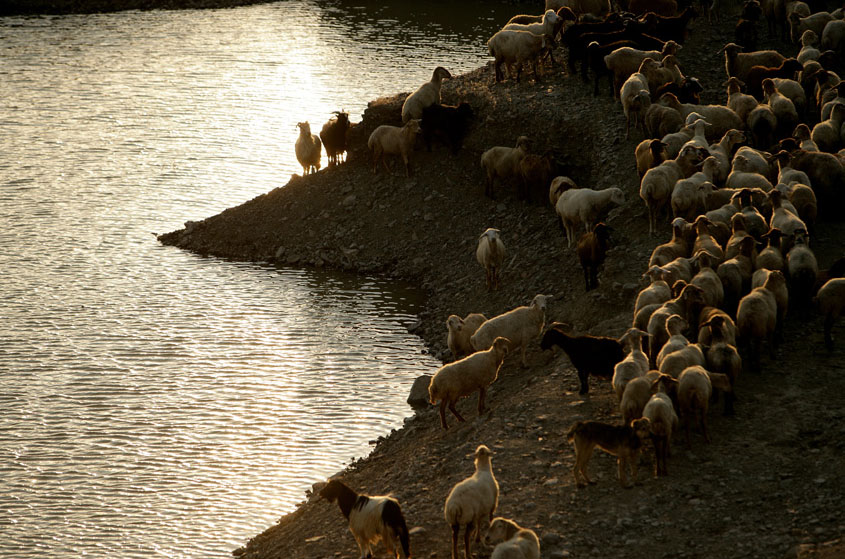
Shasavan (Moghan) Herds on River
Aras